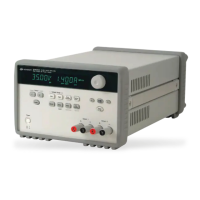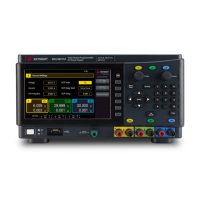1 Getting Started
50 Keysight E364xA User’s and Service Guide
Pulse loading
In some applications, the load current varies periodically from a minimum to a
maximum value. The constant current circuit limits the output current. Some peak
loading exceeding the current limit can be obtained due to the output capacitor.
To stay within the specifications for the output, the current limit should be set
greater than the peak current expected or the supply may go into the CC mode or
unregulated mode for brief periods.
Reverse current loading
An active load connected to the power supply may actually deliver a reverse
current to the supply during a portion of its operating cycle. An external source
can not be allowed to pump current into the supply without risking loss of
regulation and possible damage.
These effects can be avoided by pre-loading the output with a dummy load
resistor. The dummy load resistor should draw at least the same amount of
current from the supply as the active load may deliver to the supply. The value of
the current for the dummy load plus the value of the current the load draws from
the supply must be less than the maximum current of the supply.
Remote voltage sensing connections
Remote voltage sensing is used to maintain regulation at the load and reduce the
degradation of regulation that would occur due to the voltage drop in the leads
between the power supply and the load.
When the power supply is connected for remote sensing, the OVP circuit senses
the voltage at the sensing points (load) and not the output terminals.
Connections between the power supply sensing and output terminals should be
removed, and using a shielded two-wire cable, the power supply sensing
terminals should be connected to the load as shown in Figure 1-7.
Do not use the shield as one of the sensing conductors and the other end should
be left unconnected.

